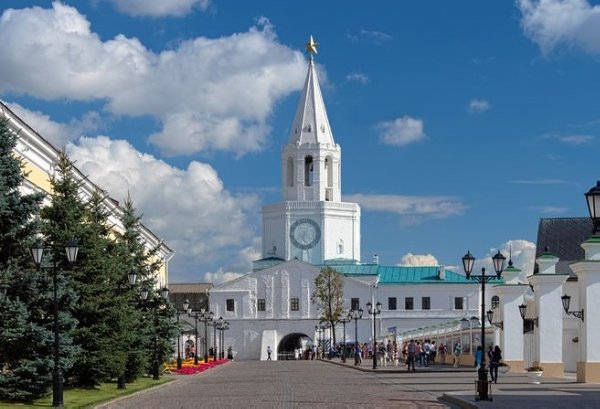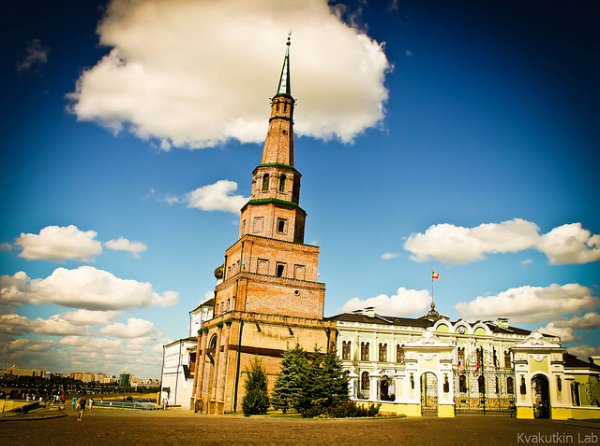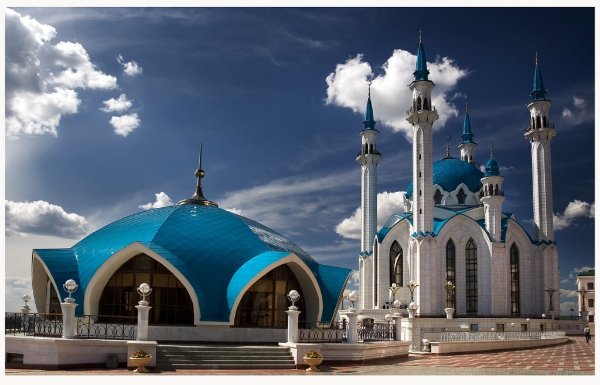Kazan celebrated its 1000-year anniversary in 2005, for which the city got a major facelift. Visitors today will be able to see many of the reconstructed or newly-constructed sites from the anniversary celebration.

Kazan Kremlin
Once a Tatar fortress, it was largely destroyed by Ivan the Terrible. During the 16th and 17th Centuries, Russians reconstructed the Kremlin with new fortifications and Russian institutions (such as the Annunciation Cathedral). Many of the features of the Kremlin reflect Russian influence of that era, and the construction of the parapets and watchtowers is particularly reminiscent of other dominant Russian cities of the time, such as Pskov and Novgorod. Entry to the Kremlin is through the white clock tower (the Spasskaya Tower) at the end of Bauman Street. Entry costs 300 Rubles with a guided tour, or 20 Rubles to explore the grounds on one's own. There are several interesting things to see inside the Kremlin, including:

The legend of the Suyumbike Tower is that Tatar Princess Suyumbike was betrothed to Ivan the Terrible, but she consented to marry him only if he could build the highest tower in Kazan in seven days. Ivan accomplished the task, but Suyumbike, rather than subjugating herself and the Tatar people to the Russian ruler, climbed to the top of the tower and jumped to her death. Locals do not seem to believe that the legend is true, but they appreciate the romanticism of it. At present, the tower is not open to climb the stairs.
Named after the 16th-century Tatar imam who died defending Kazan from Ivan the Terrible's army, the Kul-Sharif Mosque was completed in 2005 after ten years of construction. It is located within the Kremlin walls, making the Kremlin facility now a symbol of multicultural harmony in multiethnic Tatarstan. Entry to the mosque is free, although visitors must pay 3 Rubles for plastic slip-covers for their shoes in order to keep the floors clean. Visitors who climb the stairs to the third floor observation balcony do not need to remove their shoes. The prayer hall on the ground floor is open only to men going to pray and the second floor balcony is for Muslim women to pray. All women, though, should cover their hair in all parts of the mosque.
From the observation balcony, visitors can appreciate the beauty of the mosque, which is built in a modern design not unlike modern Turkish mosques. The dome in the shape of a lotus flower and the many windows give the prayer hall a bright and airy atmosphere. One uniquely local feature in the mosque is the malachite columns on the minbar (the free-standing pulpit). Some of the 99 names of God are inscribed on the inside of the upper dome and on the window glass, and the name Mohammed is written in a blue disk at the front of the prayer hall. Verses from the Koran, including an incantation against envy, are written on tile in the four corners of the hall, and the names on disks suspended lower in the hall are those of the four rightly-guided caliphs and some of the early prophets.
An interesting Museum of Islam is located below the ground floor of the mosque. Entrance is free, and a tour in English may be available if the English-speaking docent is on duty. The museum also has a booklet in English that explains the exhibits that can be helpful. Some of the exhibits include displays regarding the status of Tatar language in the Soviet era, some history of the building of the mosque (note the photo of prayers being held outdoors in the 1990s before the mosque was built), and on the lower sublevel is a history of Islam in Tatarstan, which mentions of Empress Elizabeth's attempt to convert Tatars to Christianity and Catherine the Great's edict allowing mosques to be constructed.
Affiliated with the Hermitage Museum in St. Petersburg, this museum sometimes has special exhibits of interest.
The museum was one of several projects completed for the 1000-year anniversary celebration, and it is located on the former site of the Tatar sultan's mosque, which was destroyed by Ivan's army and a residence was built in its place. The building fell into disrepair over the years and a Turkish company completed the renovations for the 2005 museum opening. One must first enter on the ground floor (located just to the left of the Suyumbike Tower) and pay the 20-Ruble entry fee. A group of energetic and chatty old ladies staff the museum, although none speak much English. The ground floor section of the museum is filled with gifts to Tatarstan from foreign dignitaries on the occasion of the 1000-year anniversary, as well as a reproduction of the sultan's throne (note the gold dome of the Koran case, which is meant to hold the Koran higher than the sultan's chair) and a reproduction of the mausoleum of the sultans, the original of which is said to be underground nearby: a small square monument marks the spot in the square outside the museum. To reach the second story of the museum, one must go outside and around the corner and climb the stairs in the courtyard near the Suyumbike Tower. There is no cashier on the second floor, so visitors much go to the ground floor section first. The second floor includes a narrative history of Tatarstan, from the early settlement of the Volga-Bulgars to the early Tatar state to Tatar Autonomous Soviet Socialist Republic to Tatarstan in the Russian Federation. The guide will insist that visitors also visit a small room on the side where medals and decorations given to the president are displayed.
Bauman Street
The pedestrian zone that stretches between the Kremlin and Tokai Square and the Hotel Tatarstan. This is Kazan's Arbat, with boutiques, souvenir shops and kiosks, cafes, bars, and plenty of opportunities for people-watching. The statuary (such as a bronze carriage) is especially interesting.
The Temple of all Religions - On the outskirts of Kazan. Take bus number 2 from the center. Interesting building for architecture buffs as it features 16 towers dedicated to different religions. Construction is not complete and you cannot go inside. But it's worth a look from the outside.